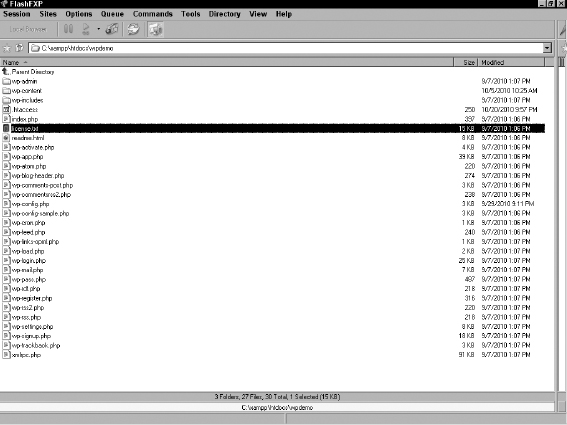Understanding WordPress Licensing
If you are bored, read the GPL text at http://www.gnu.org/licenses/gpl-2.0.html. Licensing language on any topic can be a difficult thing to navigate and understand. Mostly, have just a basic understanding of the concept of GPL and let the lawyers, if necessary, sort out the rest.
![]() A complete copy of the GPL is included in every copy of the WordPress download package in the license.txt file. The directory listing of the WordPress software files shown in Figure 2-2 lists the license.txt file.
A complete copy of the GPL is included in every copy of the WordPress download package in the license.txt file. The directory listing of the WordPress software files shown in Figure 2-2 lists the license.txt file.
Figure 2-2: The GPL text is included in every copy of WordPress.

Simply put, any iteration of a piece of software developed and released under the GPL must be released under the very same license in the future. Check out the nearby “The origins of WordPress” sidebar that tells the story of how the WordPress platform came to existence. Essentially, it was forked — meaning, the original software (in this case, a blogging platform called b2) was abandoned by its original developer, and the founders of WordPress took the b2 platform, called it WordPress, and began a new project with a new plan, outlook, and group of developers.
Once upon a time, there was a simple PHP-based blogging platform called b2. This software, developed in 2001, slowly gained a bit of popularity among geek types as a way to publish content on the Internet. Its developer, Michel Valdrighi, kept development active until early 2003, when users of the software noticed that Valdrighi seemed to have disappeared. They became a little concerned about b2's future.
Somewhere deep in the heart of Texas, one young man in particular was very concerned, because b2 was his software of choice for publishing his own content on the World Wide Web. He didn't want to see his favorite publishing tool become obsolete. You can view the original post to his own blog in which he wondered what to do (http://ma.tt/2003/01/the-blogging-software-dilemma).
In that post, he talked briefly about some of the other software that was available at the time, and he tossed around the idea of using the b2 software to “to create a fork, integrating all the cool stuff that Michel would be working on right now if only he was around.”
Create a fork he did. In the absence of b2's developer, this young man developed from the original b2 codebase a new blogging application called WordPress.
That blog post was made on January 24, 2003, and the young man's name was (and is) Matt Mullenweg. On December 26, 2003, with the assistance of a few other developers, Mullenweg announced the arrival of the first official version of the WordPress software. The rest, as they say, is history. The history of this particular piece of software surely is one for the books, as it is the most popular blogging platform available today.
Because the b2 platform was originally developed and released under the GPL, the WordPress software (all current and future iterations of the platform) must also abide by the GPL, by law. Because of the nature of the GPL, you, your next-door neighbor, or I could do the very same thing with the WordPress platform. There is nothing stopping you, or anyone, from taking WordPress, giving it a different name and re-releasing it as a completely different project. Typically, open source projects are forked when the original project development stalls or is abandoned (as was the case with b2) or (in rare cases) when the majority of the development community is at odds with the leadership of the open source project. We certainly aren't suggesting you do that because WordPress has one of the most active development communities of any open source project we've come across.
